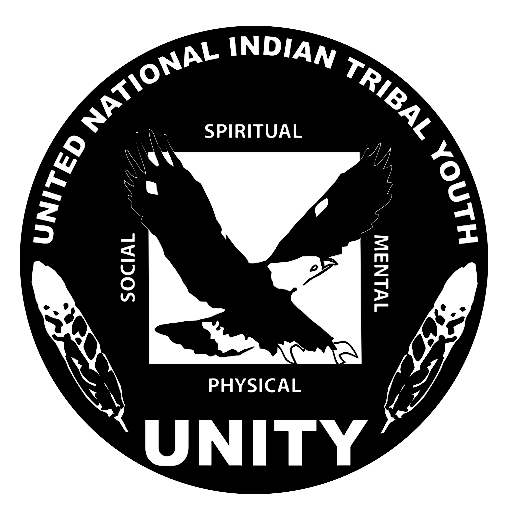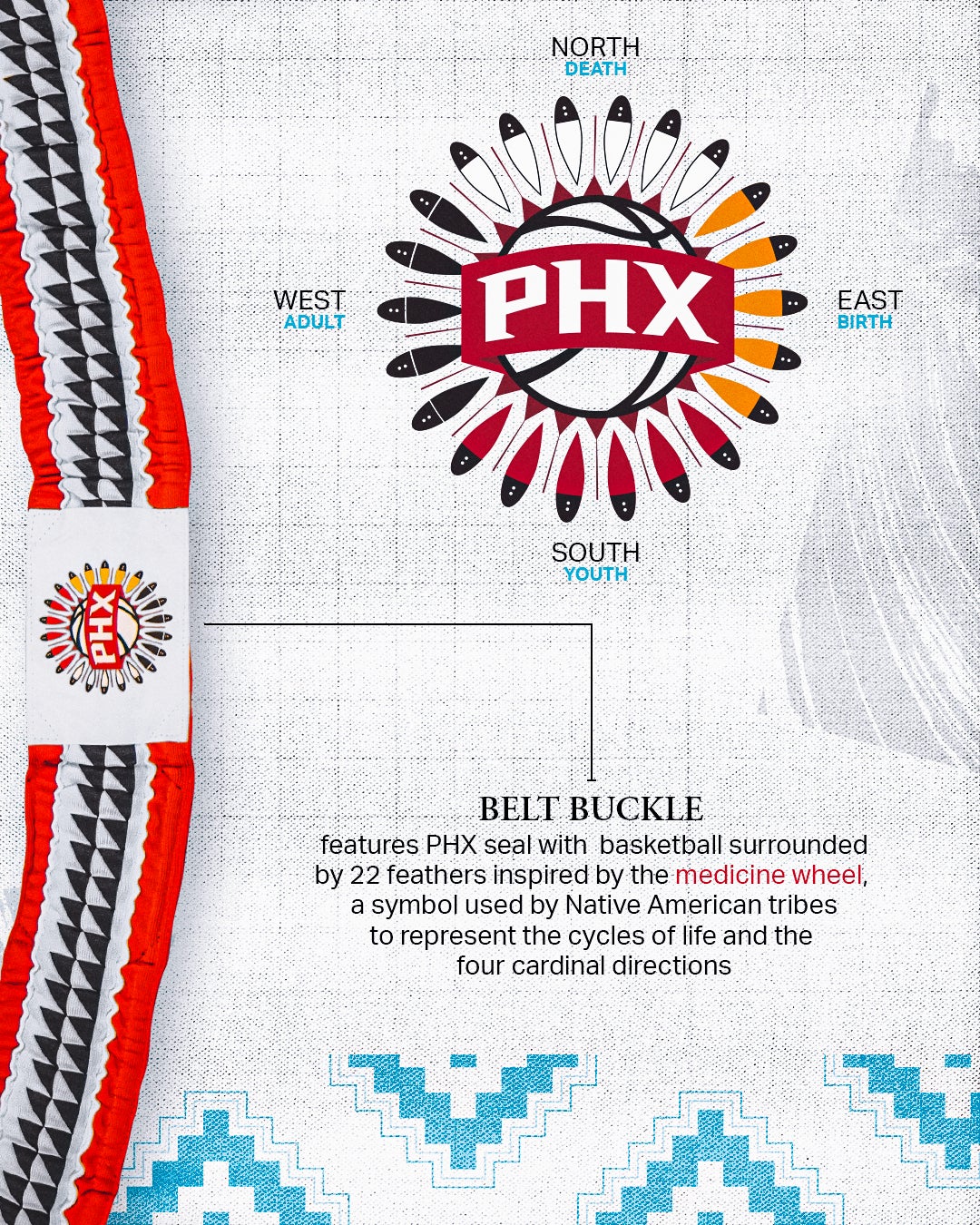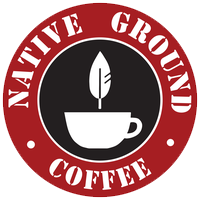Arizona is home to 22 Tribal Nations
Arizona has one of the largest urban Native American populations of any U.S. state
27% of Arizona's land is tribal

Color
The turquoise base color represents the “protection stone” or “living stone.” A color of strength, the turquoise uniforms will serve as the team’s suit of armor.
Medicine Wheel
The belt buckle features the PHX seal with basketball surrounded by 22 feathers inspired by the medicine wheel, a symbol used by Native American tribes to represent the cycles of life and four cardinal directions. The 22 feathers in the medicine wheel represents each of the state’s 22 Tribal Nations.
Translations
The black tape running down the jersey top and shorts includes the word for ‘sun’ in each of the 22 Tribal Nations native languages.
Numbers
The inline colors within the number system reflect the colors derived from the medicine wheel and colors from the official seals of all 22 tribes.
Pattern
A tribal step pattern runs down the sides of the jersey top and shorts.
Arrowheads
The 22 arrowheads lining the bottom of the shorts represents each of the state’s 22 tribes.
New Suns Uniform Shines Light, Brings Hope to Tribal Youth
Candace Hamana (Hopi, Navajo) talks with Suns players and Native youth about the significance of the new City Edition uniform and what it means to represent Arizona's Indigenous communities.
Read ArticlePLAYER REACTIONS
22 TRIBAL NATIONS
Ak-Chin Indian Community
The Ak-Chin Indian Community lies in the Santa Cruz Valley of Southern Arizona. The Community lies 35 miles south of Phoenix in the northwestern part of Pinal County and has an enrollment of more than 1,100 tribal members and a land base of just over 22,000 acres.
Cocopah Indian Tribe
The Cocopah Indian Tribe have lived along the lower Colorado River and delta for centuries maintaining their traditional and cultural beliefs. The reservation was established by executive order in 1917 and founded its first Constitution and Tribal Council in 1964. It is home to approximately 1,000 tribal members and is located approximately 13 miles south of Yuma.
Colorado River Indian Tribes*
The Colorado River Indian Tribes include four distinct Tribes - the Mohave, Chemehuevi, Hopi and Navajo. The CRIT Reservation was created in 1865 by the Federal Government for “Indians of the Colorado River and its tributaries,” originally for the Mohave and Chemehuevi, who had inhabited the area for centuries. People of the Hopi and Navajo Tribes were resettled to the reservation in the 1940s and 1950s. There are currently about 4,277 active Tribal members. The reservation stretches along the Colorado River on both the Arizona and California side. It includes almost 300,000 acres of land, with the river serving as the focal point and lifeblood of the area.
Fort McDowell Yavapai Nation
Located in Maricopa County, the Fort McDowell Reservation lies approximately 23 miles northeast of Phoenix. The reservation was designated in 1903 when the kwevikopaya, or Southeastern Yavapai, who lived in the Mazatal-Four Peak and Superstition Mountain region, were granted 24,680 acres of the old Fort McDowell Military Reserve. Fort McDowell is also the birthplace of one of the first known advocates of human rights, Dr. Carlos Montezuma (Wassaja). Today, tourism, a sand and gravel operation and agriculture form the basis of Fort McDowell’s economy.
Fort Mojave Indian Tribe*
One of two Arizona tribes that hold lands in three states, the Fort Mojave Indian Tribe, or “People Along the Water,” have lands in Arizona, California and Nevada, all along the Colorado River. Mojave culture traces the earthly origins of its people to Spirit Mountain, the highest peak in the Newberry Mountains, located northwest of the present reservation inside the Lake Mead National Recreation Area.
Fort Yuma Quechan Tribe
Home of the Quechan (pronounced Kwhu-tsan) Indians, Fort Yuma-Quechan Reservation is situated along both sides of the Colorado River near Yuma, Arizona. The reservation borders the states of Arizona, California, Baja California and Mexico, and it encompasses 45,000 acres. Interstate 8 bisects it on the south. Largely an agriculture community, the Tribe leases its thousands of acres for agriculture to both Indian and non-Indian farmers.
Gila River Indian Community
The Gila River Indian Community (GRIC) is comprised of two tribes, the Akimel O’otham (Pima) and the Pee Posh (Maricopa). The 372,000 acres of tribal lands are located just south of and adjacent to Phoenix, Tempe, Chandler, and Queen Creek. It was established by an act of Congress in 1859 and today is home to over 21,814 people. Tribal administrative offices and departments are located in Sacaton. Agriculture, tourism, industrial parks and other tribal enterprises provide employment for both tribal members and non-tribal members.
Havasupai Tribe
For over a thousand years the remote village of Supai has been home to the Havasu Baaja, People of the Blue Green Water, or as they are known today, the Havasupai Tribe. The tribe’s land consists of 188,077 acres of canyon land and broken plateaus abutting the western edge of the Grand Canyon’s South Rim. To reach the reservation, visitors must follow an eight-mile hiking or horseback trail to Supai village. With a population of around 700 people, Havasu (Cataract) Canyon, is now the permanent home of the Havasupai Indian Tribe.
Hopi Tribe
The Hopi people trace their history in Arizona to more than 2,000 years, but their history as a people goes back many more thousands of years, making the Hopi one of the oldest living cultures in documented history. A deeply religious people, they live by the ethics of peace and goodwill. The Hopi Tribe is a sovereign nation located in northeastern Arizona. The reservation occupies part of Navajo and Coconino counties and encompasses more than 1.5 million acres and is made up of 12 villages on three mesas.
Hualapai Tribe
The Hualapai live on a reservation encompassing a million acres along 108 miles of the Colorado River and the Grand Canyon on a middle section of the river corridor they call “Hakataya” or “the backbone of the river.” The reservation was created in 1883 by Executive Order and Peach Springs, 50 miles east of Kingman on Historic Route 66, is the tribal capital. The Hualapai Tribe, which has approximately 1,500 members, occupies part of three northern Arizona counties: Coconino, Yavapai and Mohave. Tribal businesses include Grand Canyon West and the Grand Canyon Skywalk.
Kaibab Band of Paiute Indians
The Kaibab-Paiute Reservation, on the Utah border, covers 120,431 acres of plateau and desert grassland. Situated along Kanab Creek in northern Arizona, the reservation is surrounded by small communities including Fredonia, one mile to the east, and Kanab, seven miles to the northeast. The Kaibab-Paiute are a member of the Southern Paiute Nation that lives along the southern Great Basin and San Juan-Colorado River drainage. The 240 members of the Kaibab-Paiute Tribe speak a Uto-Aztecan language, in addition to English.
Navajo Nation*
The vast Navajo Nation extends into the states of Arizona, New Mexico and Utah. Approximately the size of the state of West Virginia, it contains more than 27,000 square miles, making it the largest reservation in the United States. Approximately 250,000 members are enrolled in Navajo Nation, of which 168,996 reside on the reservation. The Navajo Nation offers a wide spectrum of cultural events throughout the year, including traditional song and dance contests and inter-tribal pow-wows. It is home to the “World’s Largest American Indian Fair,” the Navajo Nation Fair, among other celebrations.
Pascua Yaqui Tribe
Descendants of the ancient Toltecs who once ranged from northwestern Mexico upwards to southern Colorado and California, the Pascua Yaqui migrated to the United States in the late 19th century. Today, many Yaquis live in a village called Pascua Village, which was annexed into the City of Tucson in 1952. Another group resides in Guadalupe, close to Tempe and Phoenix. Pascua Yaqui Tribal lands are located on 222 acres in southeastern Arizona, approximately 15 miles southwest of Tucson. Congress formally established the reservation in 1964. Today the tribe numbers approximately 9,021 people.
Pueblo of Zuni
The Zuni Pueblo is nestled in a scenic valley, surrounded by the enchanting mesas, located about 150 miles west of Albuquerque. The main reservation is located in the McKinley and Cibola counties in the western part of New Mexico. The estimated number of acres encompasses about 450,000 acres. The tribe has land holdings in Catron County, New Mexico and Apache County, Arizona, which are not adjoining to the main reservation. Zuni jewelers are known worldwide for their intricate inlay work and no visit to Zuni Village is complete without visiting both the many trading posts in town and the Zuni Mission.
Salt River Pima-Maricopa Indian Community
The Salt River Pima-Maricopa Indian Community is a sovereign tribe located in the metropolitan Phoenix area. The Community is located 15 miles northeast of Phoenix adjacent to Scottsdale, Tempe, Fountain Hills and Mesa. It is home to over 9,000 enrolled members who represent two Indian tribes: the Pima ( Akimel O’odham or “River People”) and Maricopa (Xalychidom Piipaash or “People who live toward the water”). Created by Executive Order on June 14, 1879, the Community operates as a full-service government and oversees departments, programs, projects, and facilities. The Community encompasses 52,600 acres and maintains 19,000 of its acres as a natural preserve.
San Carlos Apache Tribe
The San Carlos Apache Indian Reservation spans Gila, Graham and Pinal Counties in southeastern Arizona, and stretches over a landscape that ranges from alpine meadows to desert. Encompassing 1,834,781 acres, the San Carlos Apache Reservation was established by executive order on November 9, 1871. Over one-third of the community’s land is forested (175,000 acres) or wooded (665,000 acres). As a result, the reservation is a habitat for many wildlife species including elk, mule deer, turkeys, black bears and mountain lions. The Apaches are believed to be descendants of the Athabascan family who migrated to the Southwest in the 10th century.
San Juan Southern Paiute Tribe
The San Juan Southern Paiute Tribe is a federally recognized Indian Tribe with territory located in northern Arizona and southern Utah. In Utah, tribal members reside in and around the communities of Navajo Mountain, White Mesa and Blanding. In Arizona, tribal members reside in and around the communities of Hidden Springs, Rough Rock, Willow Springs, Tuba City and Cow Springs. Paiute Canyon, which is in both Arizona and Utah, is also included in their traditional territory. The San Juan Southern Paiute people are known for their beautiful and distinctive basket weaving.
Tohono O'odham Nation
The Tohono O’Odham Nation is a federally-recognized tribe that includes four non-contiguous land parcels and approximately 28,000 members located in southwestern Arizona. The Nation is the second largest reservation in Arizona in both population and geographical size, with a land base of 2.8 million acres, comparable in size to the state of Connecticut. Boundaries begin south of Casa Grande and encompass parts of Pinal and Pima counties before continuing south into Mexico.
Tonto Apache Tribe
The Tonto Apache Tribe is located adjacent to the town of Payson (originally named Te-go-suk – “Place of the Yellow Water”), in northwestern Gila County. The reservation is approximately 95 miles northeast of Phoenix and 100 miles southeast of Flagstaff, Arizona. Consisting of 85 acres, it is the smallest land base reservation in the state of Arizona. With a total population of approximately 140 members, nearly all live on the reservation. The Tonto Apache Tribe was federally recognized by a Congressional Act in 1972.
White Mountain Apache Tribe
The White Mountain Apache tribe is located in the east central region of Arizona, 194 miles northeast of Phoenix. Located in Apache, Gila and Navajo counties, the White Mountain Apaches reside on 1.6 million acres at its ancestral homeland on the Fort Apache Indian Reservation. The Fort Apache Indian Reservation was established by Executive Order on November 9, 1891. It is now known as the White Mountain Apache Reservation and stretches over a terrain that ranges from 11,000 feet in the mountains to 3,000 feet at the Salt River Canyon. Originally, the reservation included the San Carlos Apache Reservation, which was separated by an act of Congress in 1897. White Mountain Apache Tribe is renowned for its big game hunting, Sunrise Ski Park, and abundant recreational areas.
Yavapai-Apache Tribe
The Yavapai-Apache Nation is located 95 miles north of Phoenix in central Yavapai County, in an area referred to as the Verde Valley. Two distinct tribal people, the Northwest Yavape’ people (Yavapai) and Dilzhe’e (Tonto Apache) people of the Verde Valley share a dual history and culture, as well as a common community and political organization. The two tribes remain distinct with separate identities and histories stretching independently into the past. The reservation was established in 1871 however in 1875 it was abandoned when the people were moved against their will to the San Carlos Apache Reservation. A migration back to their traditional homeland began immediately after 1900 and the reservation was re-established in 1909.
Yavapai-Prescott Indian Tribe
The Yavapai-Prescott Indian Reservation consists of 1,409 acres that are adjacent to the city of Prescott, Arizona, in central Yavapai County. Positioned at a crossroads for commerce, this reservation is intersected by U.S. Highway 89, State Highway 69, and the Atchison, Topeka and Santa Fe Railway. Several hundred acres of reservation land has been closed to development to maintain its natural beauty. Approximately 158 members belong to the Yavapai-Prescott Indian Tribe.



























